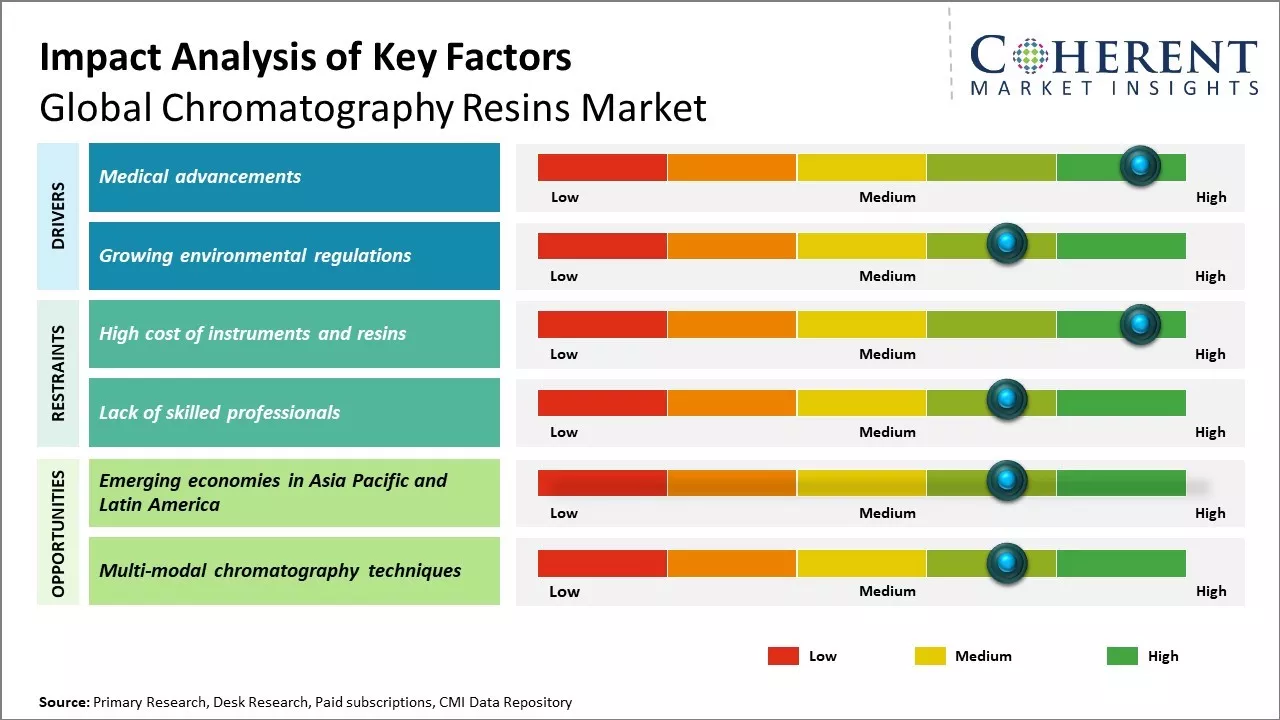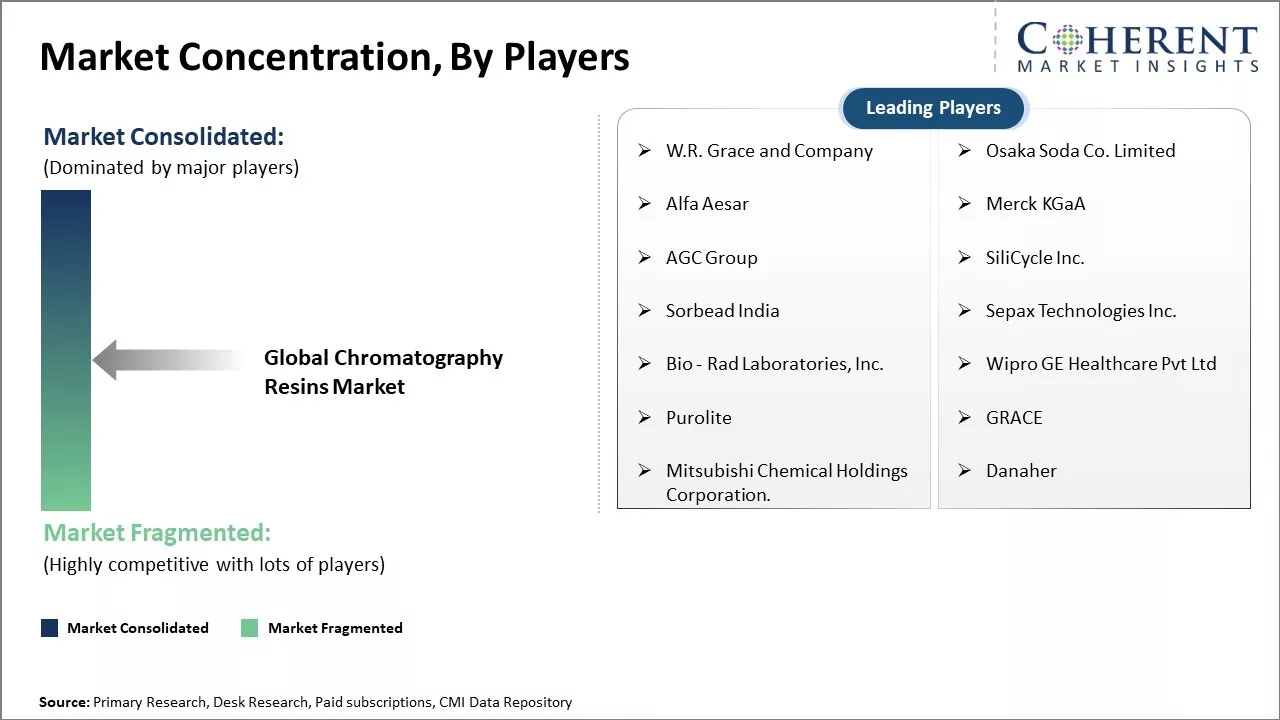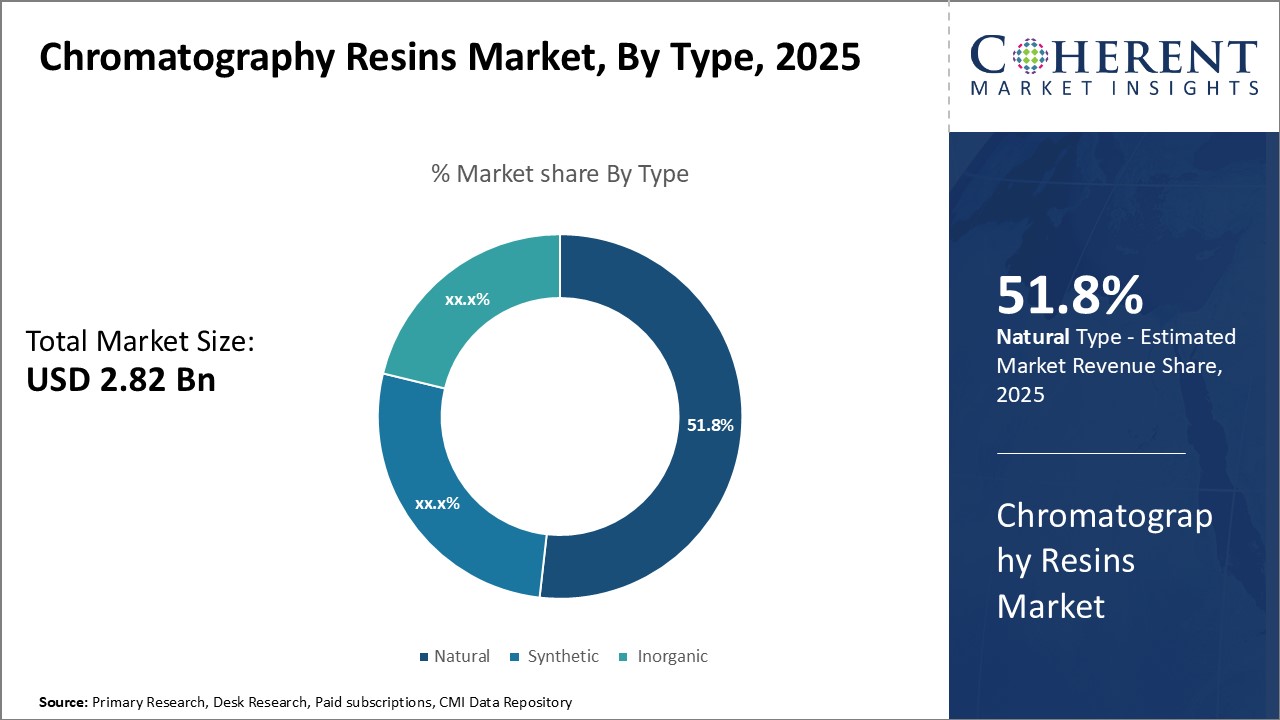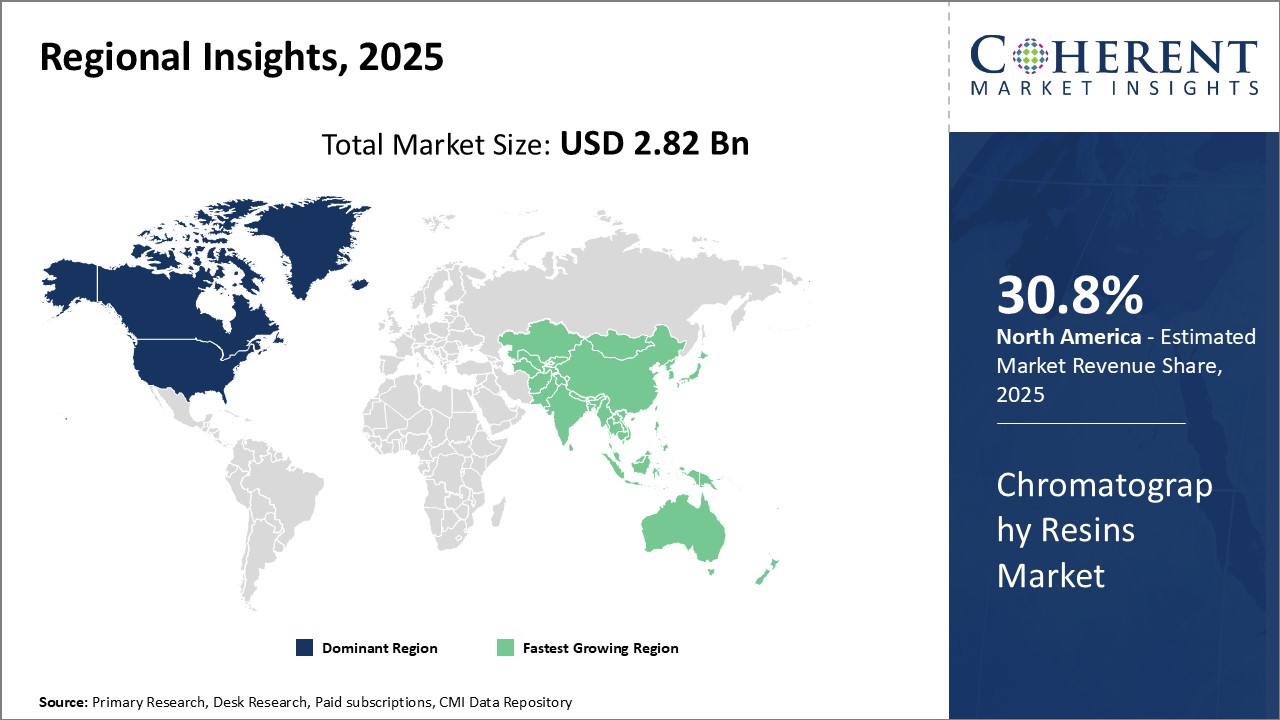The chromatography resins market is estimated to be valued at USD 2.82 Bn in 2025 and is expected to reach USD 4.51 Bn by 2032, exhibiting a compound annual growth rate (CAGR) of 6.9% from 2025 to 2032.

Discover market dynamics shaping the industry: Request sample copy
Rising demand from the pharmaceutical industry is expected to be a key driver. Pharmaceutical companies are increasingly relying on chromatographic techniques for the large-scale purification of drugs during manufacturing. This is increasing the demand for high-performance chromatography resins that can efficiently separate and purify complex biomolecules. Furthermore, growing investments by resin manufacturers to develop advanced biocompatible resins for use in protein chromatography applications will further support the market growth over the coming years. Wide applications of chromatography across various industries, such as food and beverage testing, environmental testing, and biotechnology, are also boosting the chromatography resins market growth.
Drivers of the Market:
Medical advancements
The chromatography resins market has seen considerable growth due to increased investments in the research and development of biotherapeutics like monoclonal antibodies. Chromatography finds widespread application in the purification and isolation of biologics during drug manufacturing and production. Rise in non-communicable diseases like cancer has fueled the demand for biologic drugs. More effective targeted therapies are being designed that counter specific pathologies. Their development relies on the ability to analyze intricate protein structures and interactions at the molecular level. Chromatography resins provide a reliable means to isolate biologic compounds from complex production samples. They assist in characterizing molecular properties and ensuring purity standards are met before drugs can enter clinical testing and commercial production. Ensuring drug safety and efficacy is a top priority for regulatory bodies as well as pharmaceutical manufacturers. This has encouraged innovations in chromatography resin design that offer improved selectivity, capacity, and resolution for complex separation tasks. The development of next-generation biologics will continue propelling investments in R&D and analytical capabilities, driving the need for advanced chromatography resins.

Get actionable strategies to beat competition: Request sample copy
Growing environmental regulations
Growing environmental regulations around the world focus on tighter emission control and treatment of industrial wastewater. This has significantly impacted process industries that extensively use water in their operations like food and beverage, chemicals, energy, and mining. Stringent discharge norms stipulate lowering toxin and metal levels before wastewater is disposed into municipal systems or environment. Traditionally, industries relied on pH adjustment, flocculation, and sedimentation for primary treatment. However, these conventional methods are unable to sufficiently reduce dissolved impurities. Chromatography finds increasing application as an effective tertiary treatment step to remove dilute contaminants that slip past previous processes. Resins successfully bind and isolate specific pollutants through selective adsorption. This helps companies achieve much deeper decontamination to satisfy regulatory compliance. Moreover, treated water can often be recycled within facilities, thus promoting sustainability and cost savings on water procurement. With tougher environmental mandates getting rolled out globally, process industries are compelled to upgrade wastewater treatment protocols. This shifts demand towards specialized chromatography solutions for advanced purification needs. Rising emphasis on green manufacturing also supports the growth of the chromatography resins market.
Key Takeaways from Analyst:
The global chromatography resins market is expected to experience steady growth over the forecast period driven by increasing R&D spending in pharmaceutical and biotechnology industries. Chromatography techniques have widespread usage in downstream processing of biotherapeutics. Moreover, growing prevalence of chronic diseases is prompting drug manufacturers to develop more targeted therapies which, in turn, will push investments in the market.
High costs associated with chromatography resin operations could hinder market growth to some extent. Development of robust purification techniques require expensive resins and operators also need advanced expertise to operate complex chromatography equipment.
North America is anticipated to continue dominating the global market supported by a strong presence of leading pharmaceutical companies and widespread funding for life science research in the region. The Asia Pacific region is poised to emerge as the fastest growing regional market owing to the increasing penetration of global pharmaceutical players and rising investments by national governments to develop the local life sciences industry.
Market Challenges: High cost of instruments and resins
The high cost of chromatographic instruments and resins is posing a serious challenge for the widespread adoption of chromatography techniques. Chromatography processes require specialized instruments equipped with sophisticated control systems for efficient separation, detection, and analysis of samples. These instruments such as liquid chromatographs, gas chromatographs, and other allied equipment involve significant capital investment running into several thousands of dollars. Moreover, the need for periodic upgrades and replacement of some components to keep instrumentation up-to-date also contributes to the overall operational expenses. The resins used for sample purification and separation are also expensive, with the price varying based on their grade, polymeric structure, particle size, and functionality.
Market Opportunities: Emerging economies in Asia Pacific and Latin America
Emerging economies in the Asia Pacific and Latin America regions provide massive opportunities for growth in the chromatography resins market. These regions are witnessing rapid industrialization and expansion in sectors like pharmaceuticals, biotechnology, and life sciences. Countries like India, China, Brazil, and Mexico are emerging as global manufacturing hubs for bulk drugs, generics, and biosimilars. According to UN Comtrade data for 2021, India and China collectively accounted for over 60% of global exports in basic pharmaceutical products and 30% in medical instruments. Their bulk drug exports grew at an annual rate of 10-15% between 2020 and 2022. This points towards a huge demand for various separation technologies like chromatography in these nations.

Discover high revenue pocket segments and roadmap to it: Request sample copy
Insights by type: Natural Advantage
In terms of type, natural is expected to contribute 51.8% share of the market in 2025, owing to various inherent advantages over synthetic resins. Natural resins are obtained directly from plant and animal sources without any chemical modifications, making them completely biodegradable and environment-friendly. They also have excellent physicochemical properties suited for chromatography applications. For example, cellulose resins have hydrophilic hydroxyl groups allowing strong interactions with polar solutes during separation. Dextran resins contain branched polysaccharide chains that enable separation of biomolecules based on molecular size. Additionally, natural resins are relatively inexpensive and provide a "green" alternative to synthetic resins involved in downstream processing of biologics. Their biocompatible nature makes them suitable for applications in food and pharmaceutical industries where leachable concerns exist with synthetic resins. Furthermore, end users prefer natural resins due to stringent environmental regulations restricting the use of certain synthetic resins. Overall, natural resins have emerged as a popular choice in chromatography due to their inherent eco-friendly and application-specific advantages over other resin types.
Insights by technique: Dominance of Ion Exchange
In terms of technique, ion exchange is expected to contribute 32.7% share of the market in 2025, owing to its versatile applications across various industries. Ion exchange chromatography separates analytes based on differential electrostatic interactions between ionized functional groups on the stationary phase and ionized analytes in the mobile phase. It offers high resolution and can efficiently separate a variety of biomolecules such as proteins, peptides, nucleic acids, and small molecules. The most widely used ion exchange resins include agarose, silica-based, and polysaccharide-based resins having various charged substituents to manipulate solute interactions. Ion exchange also has low equipment and operating costs. Its ability to work under mild conditions makes it the preferred choice for separation of labile biomolecules. Furthermore, the commercial availability of ion exchange media in different chemistries, pore sizes, and matrices helps achieve selective separations. Applications are extensive across bioanalytical, bioprocessing, environmental food, and forensic sectors driving its market prominence.
Insights by end-use : Role in Pharma & Biotech Progress
In terms of end-use, pharmaceutical & biotechnique is expected to contribute 33.9% share of the market in 2025, owing to chromatography's vital role in modern biopharmaceutical development and production. At each stage of drug manufacturing - from upstream and downstream processing to formulation development - chromatography finds wide use. It helps purify biotherapeutic products with high selectivity and capacity to separate complex mixtures. Monolithic resins having excellent mass transfer properties are suited for large-scale purification of monoclonal antibodies. Affinity resins are used to isolate recombinant proteins in bio-production processes. Ion exchange resins aid in polishing steps to remove contaminants and process-related impurities. Further, different resins have applications in the purification of plasma -derived medicines, vaccines, biosimilars, and gene and cell therapies. Chromatography also enables characterization, quality control, and stability testing of biopharmaceuticals to ensure safety, efficacy, and consistency through a product's lifecycle. With rising demand for biologics, continuous advancement of biomanufacturing technologies, and growing regulatory stringency, the role of chromatography resins is increasingly indispensable in driving the biopharmaceutical industry progress and access to cutting-edge therapies.

Need a Different Region or Segment? Customize now
North America has historically dominated the global chromatography resins market. The region is expected to account for 30.8% of the market share in 2025, owing to the strong presence of pharmaceutical and biotechnology companies in the region. The U.S. is home to many leading pharmaceutical firms which are engaged in development and production of biotherapeutics and large molecule drugs. This has propelled the demand for various chromatography techniques and resins for purification and separation applications over the years. Additionally, heavy investments in R&D by these companies have created a robust landscape for chromatography resin suppliers to cater to their complex purification requirements. Some of the top pharmaceutical companies in the region are known to directly source resins from manufacturers based on their proprietary needs, adding to the market share. However, pricing pressures due to patent cliffs have pushed these companies to focus on cost efficiency without compromising on quality. This has benefitted chromatography resin producers who offer customized solutions and services.
The Asia Pacific region is poised to grow at an unprecedented rate in the coming years on account of emerging economies like China and India increasingly adopting modern bioprocessing technologies. Surging investments in healthcare infrastructure coupled with growing biosimilars market in these countries has boosted their biopharmaceutical manufacturing capabilities. Domestic firms are actively partnering with multinational drug makers to gain knowledge and set up large scale production facilities. This is translating into higher sales of various bioprocess consumables including chromatography resins. Additionally, price competitiveness of Asia Pacific's resin manufacturers along with their ability to meet proprietary requirements is helping them attain a sizable share of exports to other developing markets. The availability of technologically skilled workforce provides impetus to local players to compete with global leaders in the development of specialty resins.
Chromatography Resins Market Report Coverage
| Report Coverage | Details | ||
|---|---|---|---|
| Base Year: | 2024 | Market Size in 2025: | USD 2.82 Bn |
| Historical Data for: | 2020 To 2024 | Forecast Period: | 2025 To 2032 |
| Forecast Period 2025 to 2032 CAGR: | 6.9% | 2032 Value Projection: | USD 4.51 Bn |
| Geographies covered: |
|
||
| Segments covered: |
|
||
| Companies covered: |
W.R. Grace and Company, Osaka Soda Co. Limited, Alfa Aesar, Merck KGaA, AGC Group, SiliCycle Inc., Sorbead India, Sepax Technologies Inc., Bio - Rad Laboratories, Inc., Wipro GE Healthcare Pvt Ltd, Purolite, GRACE, Mitsubishi Chemical Holdings Corporation., and Danaher |
||
| Growth Drivers: |
|
||
| Restraints & Challenges: |
|
||
Uncover macros and micros vetted on 75+ parameters: Get instant access to report
*Definition: The chromatography resins market consists of various separation media materials that are used in chromatography techniques for analytical and process purposes. The resins help isolate and purify biomolecules and other chemical compounds. They play a key role in processes like protein purification, water treatment, drug discovery, and purification of antibodies. Common resin types available in this market include silica gel, polystyrene divinylbenzene, and agarose, among others. They are designed to effectively and efficiently separate target molecules from a complex mixture.
Share
Share
About Author
Vidyesh Swar is a seasoned Consultant with a diverse background in market research and business consulting. With over 6 years of experience, Vidyesh has established a strong reputation for his proficiency in market estimations, supplier landscape analysis, and market share assessments for tailored research solution. Using his deep industry knowledge and analytical skills, he provides valuable insights and strategic recommendations, enabling clients to make informed decisions and navigate complex business landscapes.
Missing comfort of reading report in your local language? Find your preferred language :
Transform your Strategy with Exclusive Trending Reports :
Frequently Asked Questions
Joining thousands of companies around the world committed to making the Excellent Business Solutions.
View All Our Clients
US Reciprocal Tax Impact Analysis On Chromatography Resins Market
Stay updated on tariff changes with expert insights and timely information